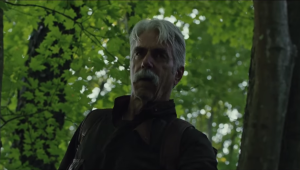FILM REVIEW: The Man Who Killed Hitler and Then The Bigfoot is a Melancholy Examination of what makes a man versus a myth

When I was a kid growing up, folk tales were something that you’d hear about growing up, especially those about folk heroes like Paul Bunyan or John Henry. These were characters that were larger than life myths who raged against an unbeatable enemy near the end of their days, usually that of automation. John Henry and his hammer vs. a steam hammer laying nails for the railways. Paul Bunyan chopping trees down with his Big Blue Ox against the lumbermill. In the end, these might have been based on real people or just aspirational figures for the working man to look up to in awe. But the myth outlived the man as the man faded into dust and legend. The Man Who Killed Hitler and Then The Bigfoot takes the tack of exploring what life might be for a figure such as this; someone who has done extraordinary things in the eyes of others, but whose best days are behind him when tasked with one last impossible mission before them.
Oscar nominee Sam Elliott (A Star is Born) plays Calvin Barr, a retired soldier tasked upon by the government to do extraordinary things during the Second World War. When we first encounter him, he’s a broken down man in a bar who gives his last few dollars away to a homeless man only to be accosted by a gang of 3 men who hold him up to steal his car and wallet. Barr tries to give him the wallet but save a picture from it, only to have the picture destroyed. For Barr, this is one step too far and the man beats the 3 would-be muggers to an inch of their lives in a scene that seems an ode of sorts to the opening of Logan. Much like Logan, Elliott’s Barr, has lived something of an extraordinary life from the outside viewpoint of the viewer. He’s been a spy for the government, a man tasked with accomplishing the impossible. But also like Logan, Barr views himself as a failure; he may have stopped historical monsters, but the deaths he wrought didn’t change anything as the ideas behind them persisted. In the end, the only thing vanquished during Barr’s missions were the personal touchstones to the life he left behind. He pantomimes his day and sets himself to die until he is contacted once again by a shadowy agent of the government (Office Space’s Ron Livingston) to accomplish the impossible for them one more time.
The Man Who Killed Hitler and Then The Bigfoot mainly works because of the sad and haunting gravitas Elliot lends to the role of the older Barr. Aiden Turner’s turn as the younger Barr doesn’t hit as well as hard as Elliot’s version of Barr; it comes across more as a historical teleplay by way of Bryan Singer’s Valkyrie. The scenes of the older Barr with his brother, played by veteran character actor Larry Miller, are the most affecting in the film. Elliot imbues the character with the sense of a life lived and the relationship between the Barr brothers defines the film, much in the same way the relationship between Bill Murray and Jaeden Lieberher defines St. Vincent (2014), the characters need each other to feel alive.
Overall, The Man Who Killed Hitler and Then The Bigfoot is a vehicle to showcase Sam Elliot; the film leaves and breathes on his performance and its what sets the film from being a low budget feature. Much like Bubba Ho Tep, its an example of a star turn defining a film and lifting it to a higher tier than it would otherwise achieve,


